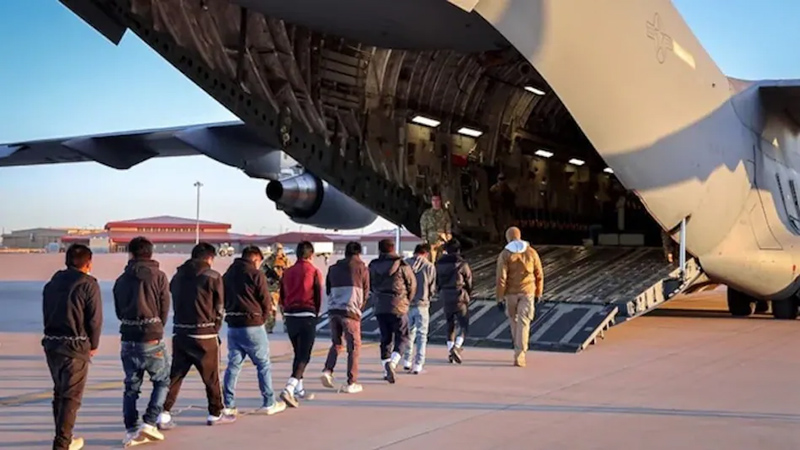Even as Indian Prime Minister Narendra Modi is scheduled to meet US President Donald Trump next week in Washington DC, the mood in India is taking a darker turn towards the US. First came the news that a US military aircraft with more than 100 illegal Indians on board has been sent back by the Trump administration. The logic was that these are people who went there by illegal means and hence the US was, well, within their rights to deport them. Though many questioned what was going on.
As the US military aircraft landed in the Indian state of Punjab, stories and visuals emerged of Indians in handcuffs, some shackled and not allowed to use the washroom for hours at length.
A video shared by Michael Banks, chief of United States Customs and Border Protection (USBP), shows Indian immigrants handcuffed with their legs chained.
“USBP and partners successfully returned illegal aliens to India, marking the farthest deportation flight yet using military transport. This mission underscores our commitment to enforcing immigration laws and ensuring swift removals. If you cross illegally, you will be removed,” Banks captioned his social media post while sharing the video.
The backlash on social media has been intense ever since, with many questioning the treatment meted out to the Indians. The Indian Parliament which is currently in session saw an uproar over the issue following which both Houses of the Parliament were adjourned till noon. Several members were also seen joining the protest sporting handcuffs on their hands.
External Affairs Minister S Jaishankar made a statement in the upper house of the Parliament on the issue today. He said that it was a fundamental responsibility for all nations to take back their citizens who are found to be living illegally abroad.
“We are engaging with the US govt to ensure that the deportees not be mistreated in any manner. At the same time, the House will appreciate that our focus should be on the strong crackdown against the illegal immigration industry,” Jaishankar said.
“On the basis of information provided by the deportees, law enforcement agencies will take necessary, preventive and exemplary action against the agents and such agencies,” he added.
While the minster tried to set the record straight and to calm the members of the house, repeated questions were raised on why a military aircraft was used by the US to send the Indians back and not a civilian one; also, on why the handcuffs and shackles since these people were not “criminals”. Members of Parliament also pointed out that a country like Colombia had criticized the US when it tried sending its citizens back in a similar fashion, so what was stopping India from doing so.
According to a report in Reuters, a recent military flight deporting migrants to Guatemala likely cost at least Rs 4,09,331 ($4,675) per person – more than five times the cost of a one-way first-class ticket on American Airlines for the same route.
By comparison, US Immigration and Customs Enforcement’s (ICE) standard chartered deportation flights cost Rs 14,88,527 ($17,000) per flight hour, with a typical flight carrying 135 deportees and lasting five hours. This translates to roughly Rs 55,163 ($630) per person, assuming the charter company absorbs the cost of the return flight.
The C-17 military aircraft used to send the illegal Indians back has an estimated operational cost of Rs 24,95,388 ($28,500) per hour. Given the distance between the US and India, this latest deportation flight is likely the most expensive one yet.
At the end of the day, this is bad news for the Indian government. Despite the statement by the foreign minister, the optics are negative. Also, this puts pressure on the Indian government as it prepares for the first Modi-Trump meet next week in Trump 2.0.
While the US is set to continue with its deportations, India will have to ensure better treatment and dignity for its citizens who are being deported by the authorities. – Simran Sodhi is Executive Editor of nrifocus.com


Leave a Reply